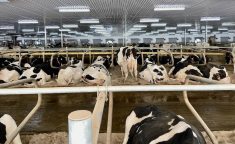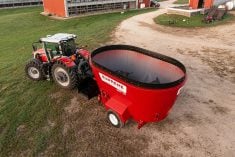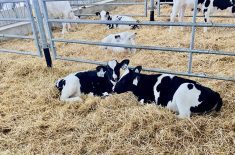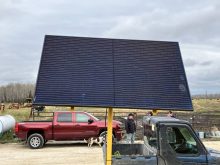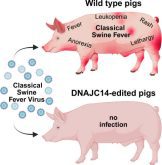Feeding cows to entice them to visit milking robots has been a best practice since cows started being milked automatically in Canada about 25 years ago.
But some farms are now questioning that rule. They argue they can get their cows to milk well without supplementing them in the robot.
WHY IT MATTERS: Taking feed pellets out of milking systems on Canadian dairies could lower costs and simplify processes for the farmer to help boost their farm’s profit.
Read Also

Beekeepers want financial protection against tropi mite
Tropilaelaps (tropi) mites haven’t landed in Canada yet; beekeepers want to know they’ll get federal financial help if the deadly bee parasite ever does
There are several advantages to the practice, dairy consultants, farmers and DeLaval staff said during a recent series of webinars discussing reducing feed in milking robots.
Robot pellets are a custom mix, so they are more expensive than an on-farm-created total mixed ration (TMR). There are extra bins and augers needed to deliver a pelted feed to a robot, and that cost can be saved by feeding all nutrition with the TMR.
“History’s proven that we do not need to feed in the parlours to keep our girls occupied while being milked,” said Kelli Hutchings, who works for DeLaval dealer High Plains Robotics in the United States.
Guided traffic alternative
The practice is, for now, only viable with robotic milking systems using guided traffic, which means when a cow enters the milking zone, she can’t leave to go back to feed until she goes through the robot.
Most other robotic systems only encourage free traffic flow, while DeLaval will install robots in barns with either system.
Two small dairy farmers in Ontario are starting up their new robotic milking systems without feed in the robot, says Fred Van Lith, herd management advisor with Norwell Dairy Systems.
One herd is milking 41 Holsteins, averaging 41 kilograms of milk per day, with three visits per cow per day to the robot.
Another, a Jersey herd, is milking 77 cows, producing 22 kilograms of milk per day, with 2.35 visits per day.
That herd is adding another automated milking system soon, which should increase the visits with more time per cow available.
Production method spreading
Van Lith says he expects five other herds to start robotic milking without feed in the robot over the next few months.
There are some larger American herds leading the way in feeding without pellets, including Matt Strickland’s Double Creek Dairy in California.
Hutchings was inspired while watching beef cows come to a feed truck to question what would happen if cows never knew that pellets were available in a robot.
He called Strickland and pitched the idea of gradually removing pellets from his milking robots. Strickland milks almost 2100 cows with robots and a parlour.
The conventionally milked cows get all they need for nutrition from the TMR, so there should be no reduction in nutrition for robot-milked cows without pellets.
Moving to pelletless
Hutchings and Strickland have been working for a year at weaning his cows from pellets in the robot and they’re down to seven cows remaining that still need something to get them into the robot.
They gradually moved the amount of nutrition and volume of pellets down over months for the herd. Milk production hasn’t changed and butterfat composition is higher, likely due to the lack of slug feeding of a pellet in the robot, says Hutchings.
Other metrics are also good, including the fact that average time in the area where cows wait for a robot increased by one minute, from 10 to 11, which means that cows are still getting milked in a timely fashion despite there being no incentive in the robot.
The larger benefit in training cows to go to a robot without supplements is for new robotic milking herds, which have never known that a treat was a possibility when they are milked. Instead, they are motivated by the need to be milked, the fact that they have to go through the robot to get back to feed and good training.
Life without pellets
Heeg Bros. Dairy in Wisconsin started up their new robotic facility and have some of the top numbers in a robot-milked herd, says Hutchings. The farm averages 48.44 kilograms of milk per cow per day and 4.55 per cent butterfat.
The 450 milking cows were started up in two groups, and there were some lessons learned, says Hutchings. The first group was put into the new barn and then herded back to the parlour for milking, which resulted in the cows wanted to head back to the parlour even when they were in the robot barn.
“They developed a habit and would go down the alley past robots, down the alley to the other barn to be milked,” says Hutchings.
The second group was milked right away in the robots and did quite well.
“This is one of the top performing barns in North America, if not globally and they’ve never seen pellets,” she said.
Back in California, Strickland’s herd has shown that there’s patience needed to wean cows off the pellets, but he’s happy so far with the results.
“I didn’t invest in robots to feed my cows, I got the robots to milk my cows,” he said.



